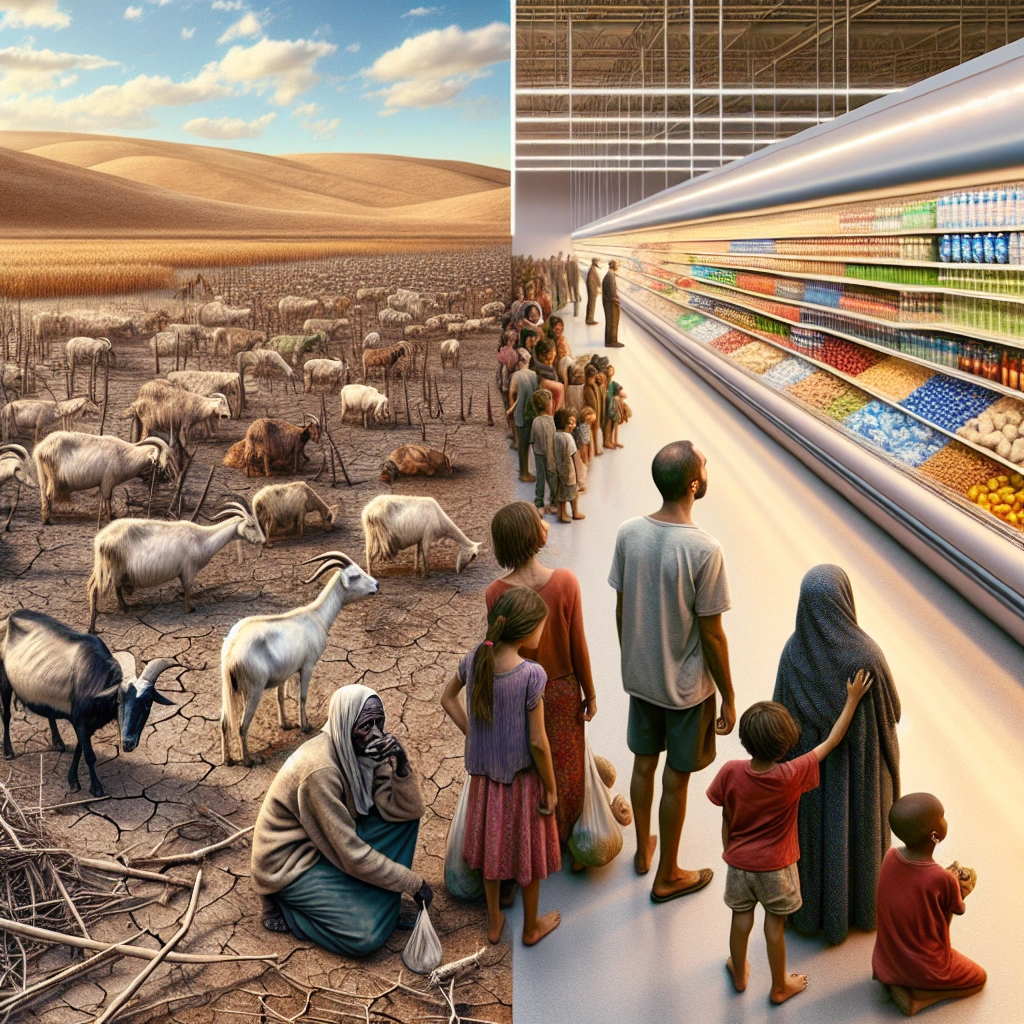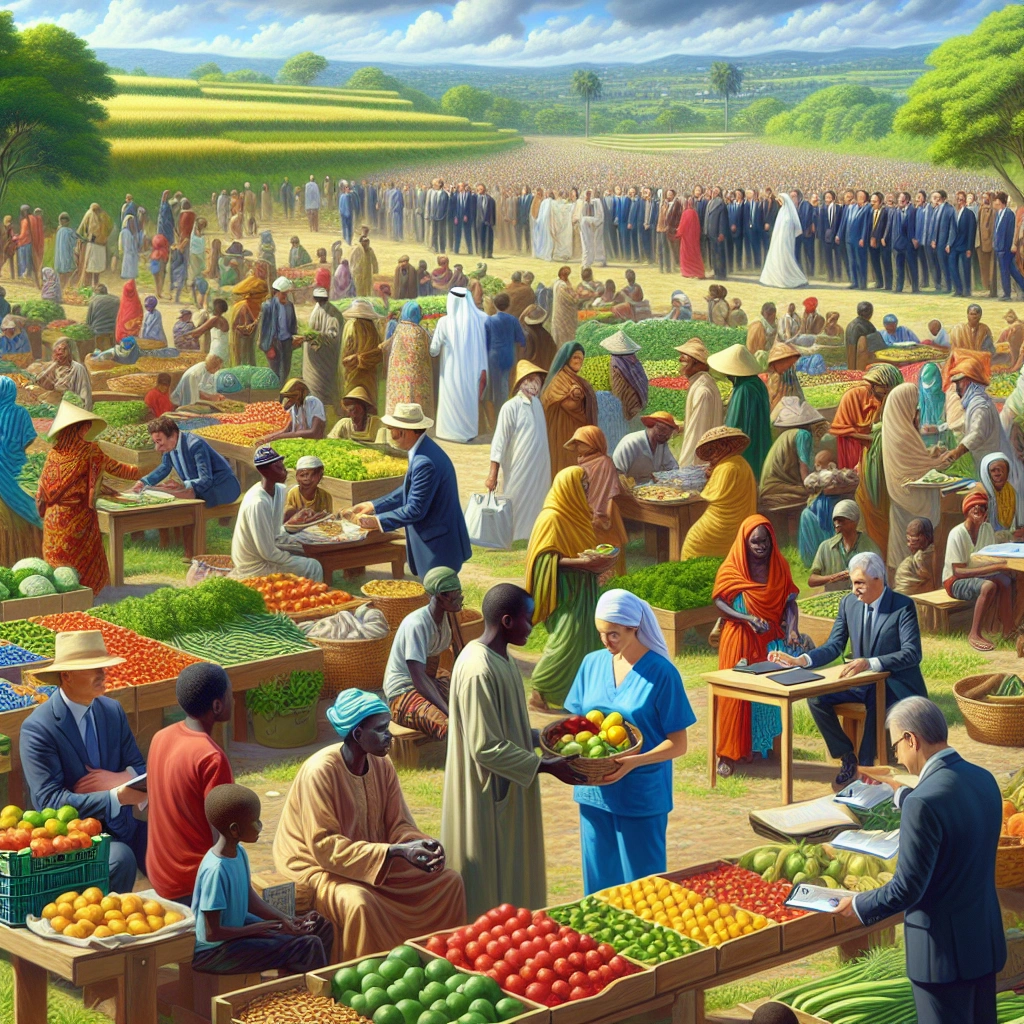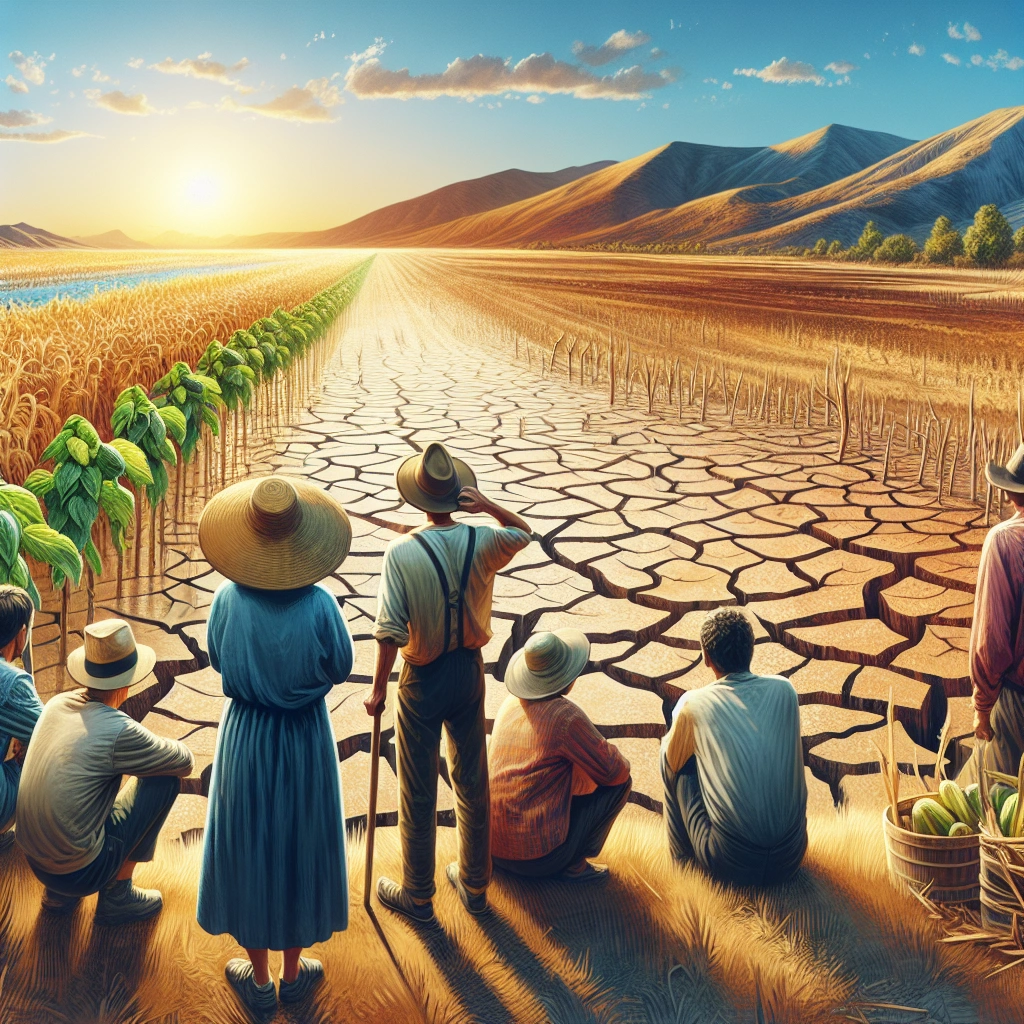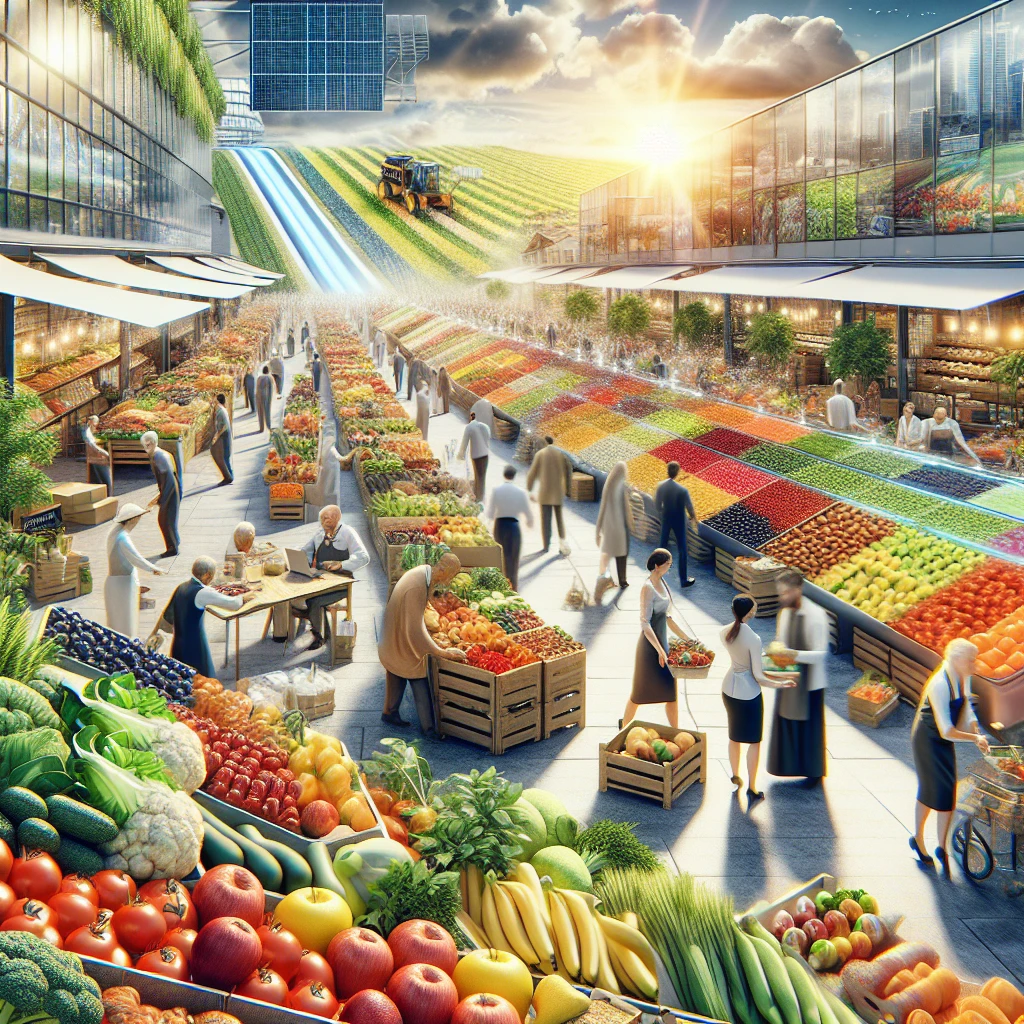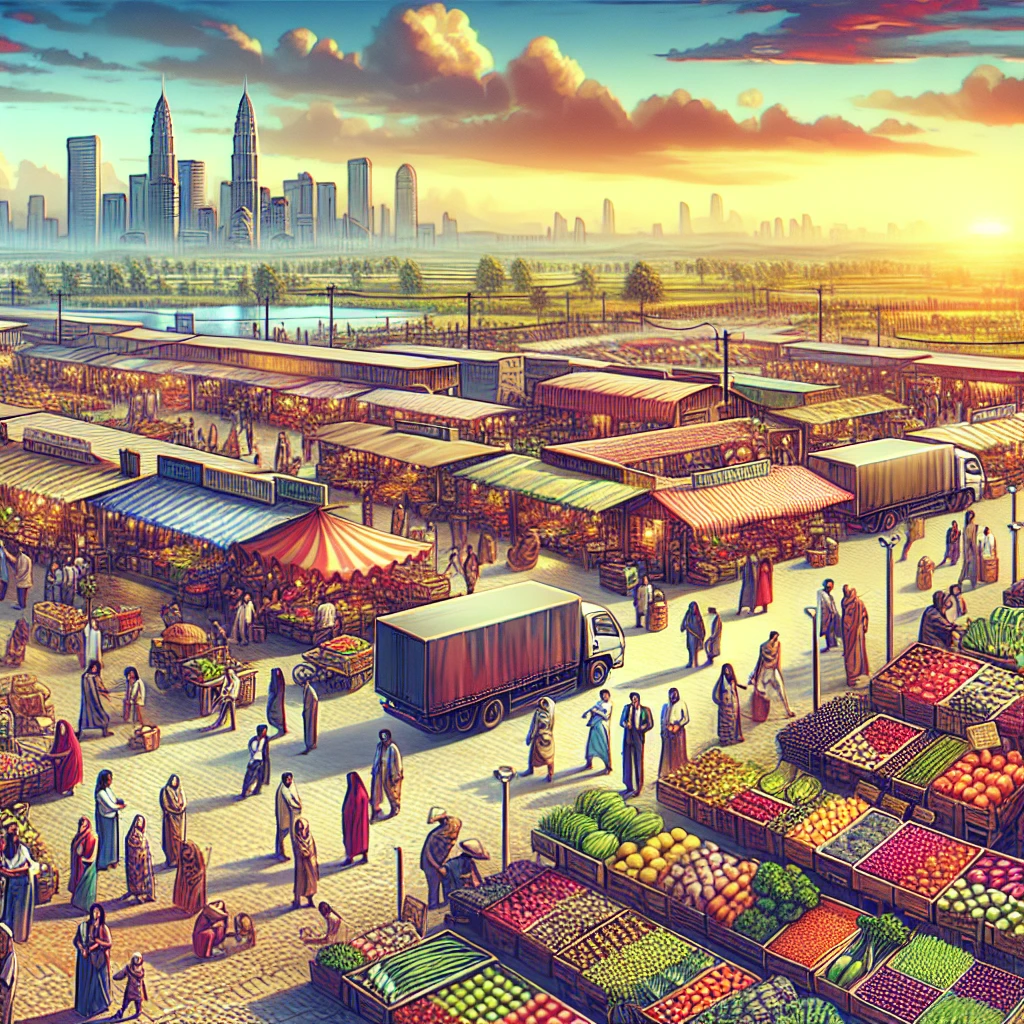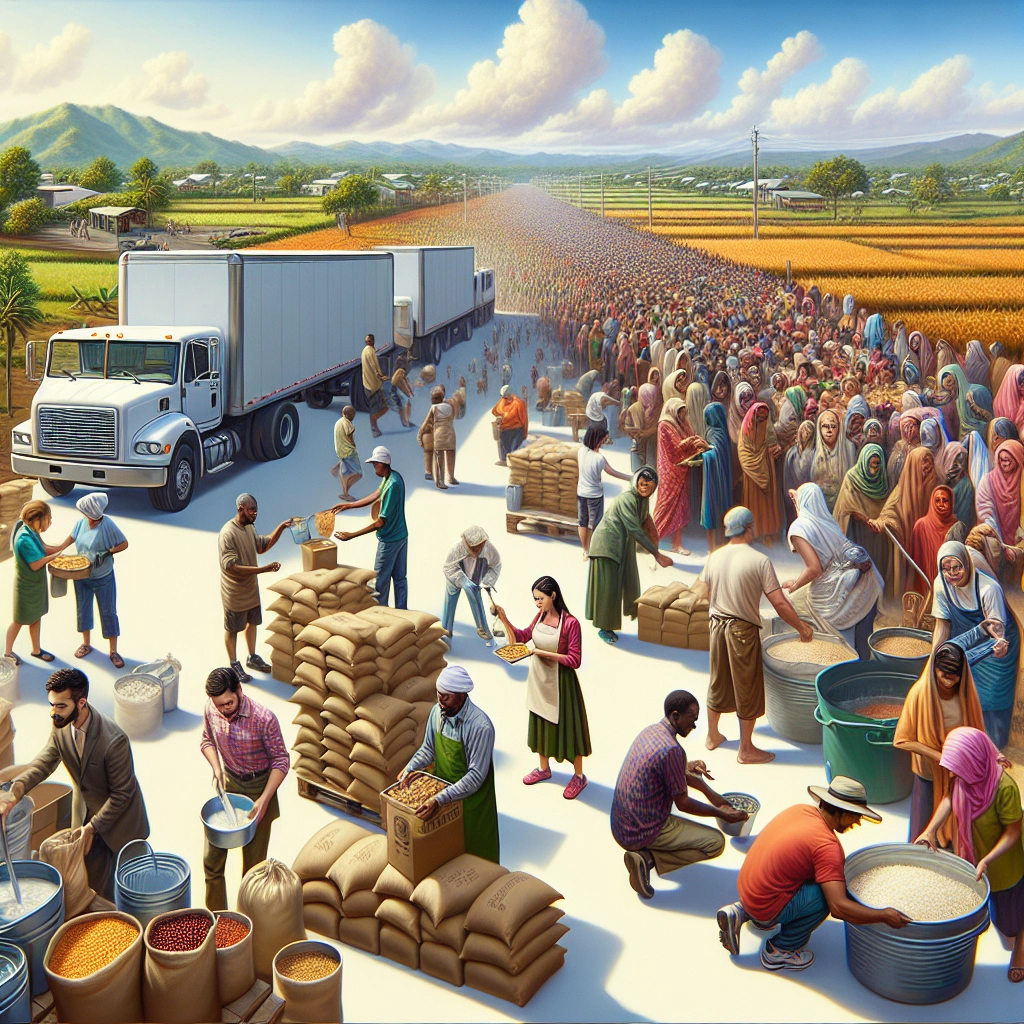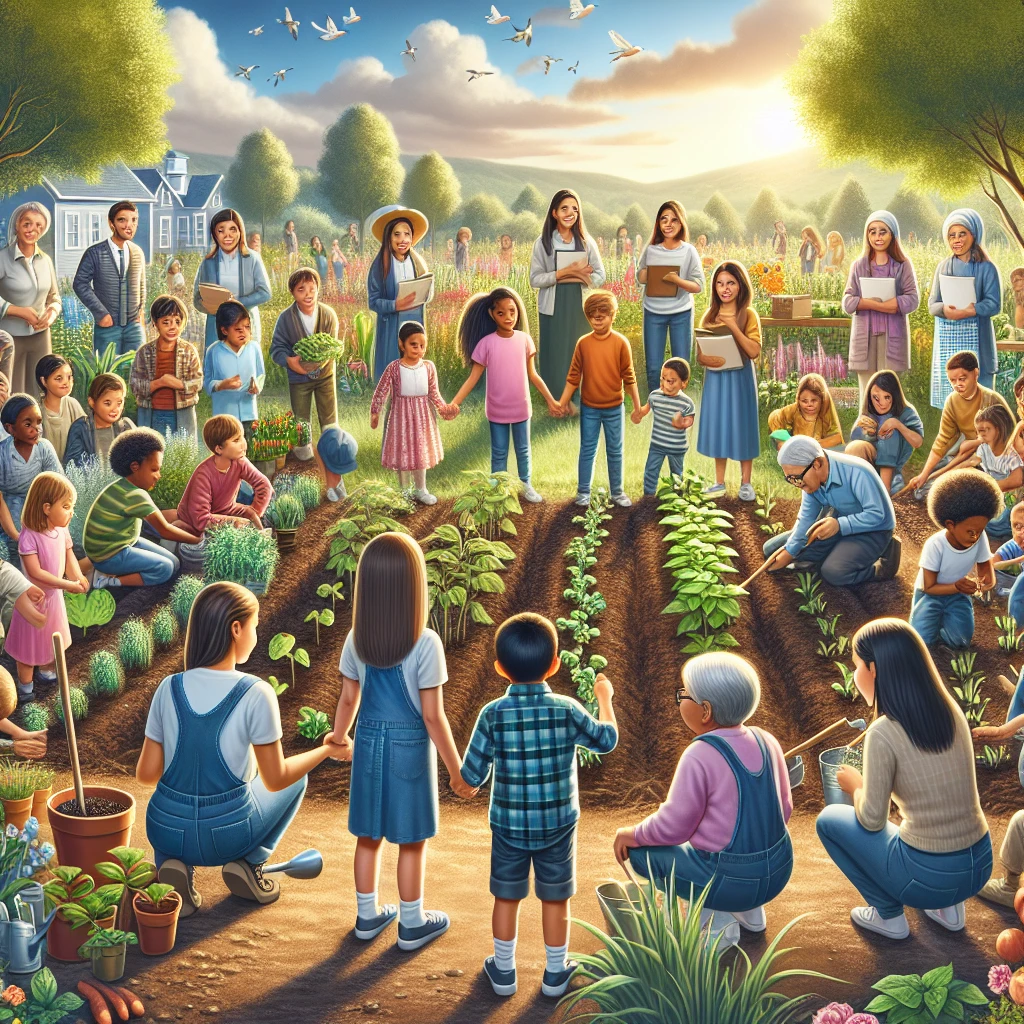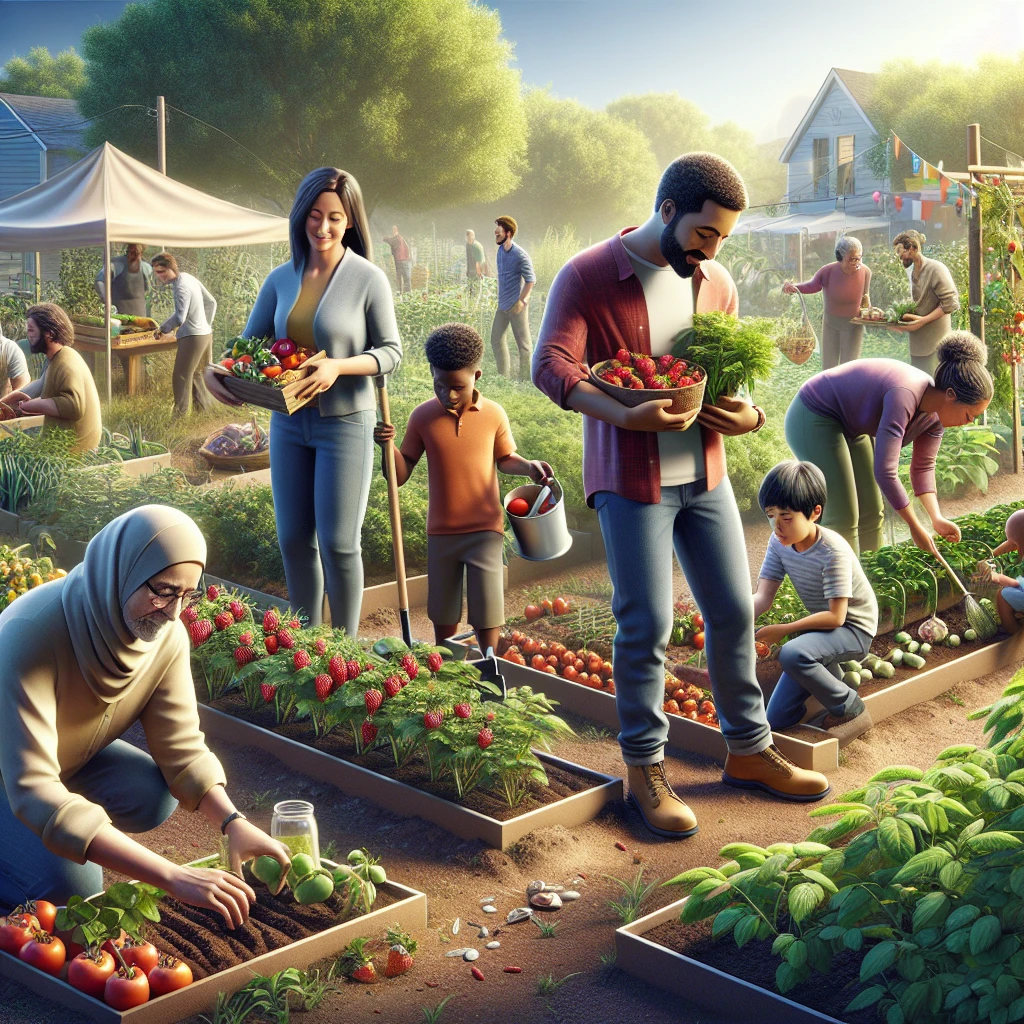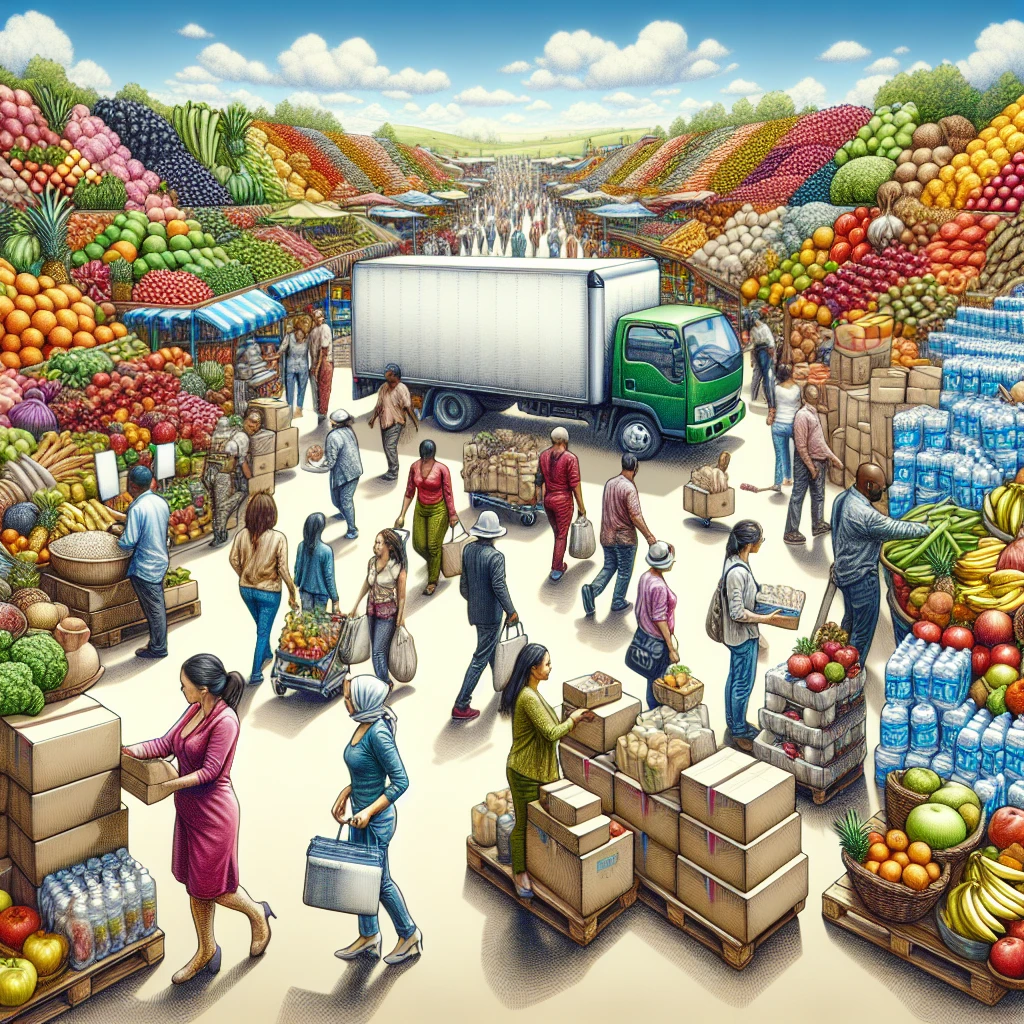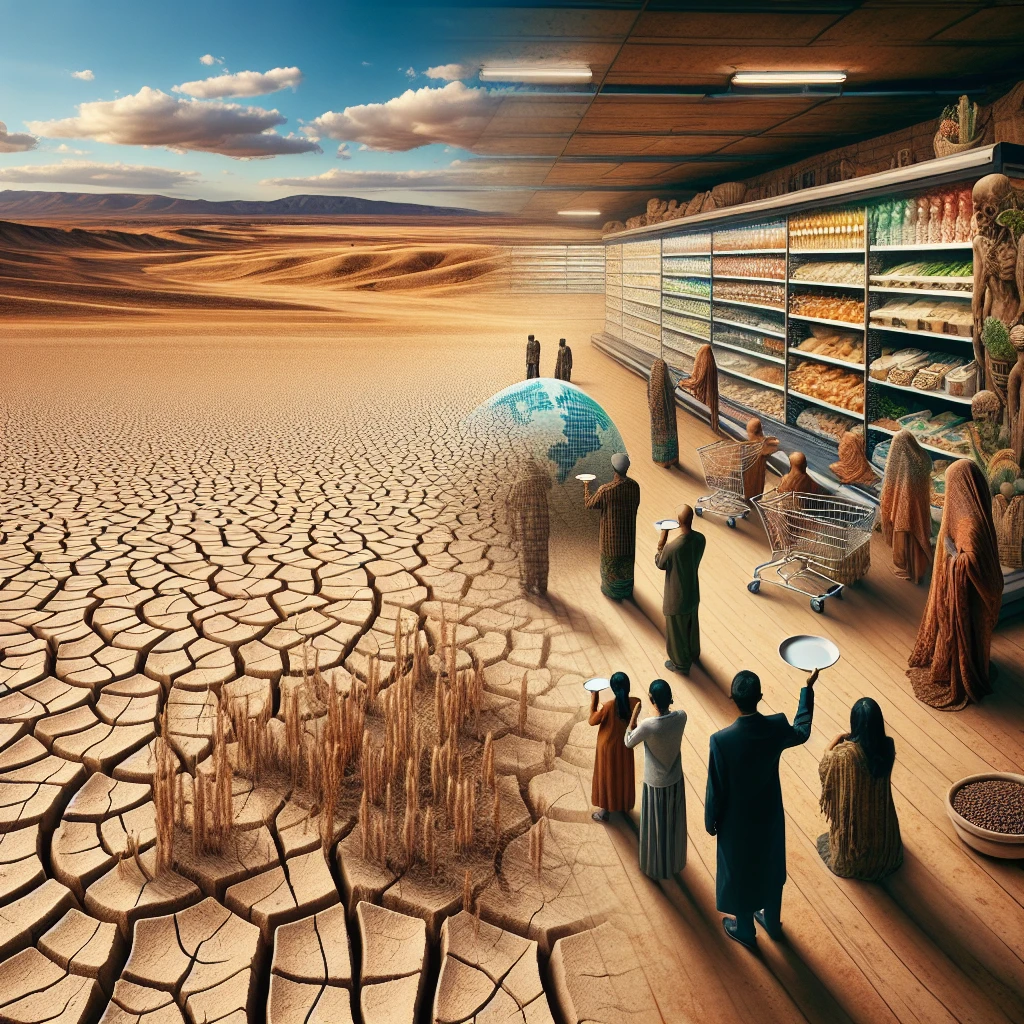

A global food crisis refers to a situation where there is a shortage of food on a global scale, leading to widespread hunger and food insecurity.
It is important to address the global food crisis because it impacts the health and well-being of millions of people around the world.
Furthermore, the global food crisis can lead to social unrest, conflict, and economic instability, making it a critical issue that requires immediate attention and action.
Check out this Youtube video: “What’s causing the global food crisis? | Inside Story – YouTube” to gain a deeper understanding of the factors driving the global food crisis and how it’s impacting our world.
Historical Background
Conflict and climate change have been the leading causes of the global food crisis. Wars and political conflicts uproot families, devastate economies, and disrupt agricultural production, leading to widespread hunger and food shortages.
Additionally, the impact of climate change on extreme weather events has led to the destruction of crops, livelihoods, and lives, exacerbating global hunger.
One example of the events leading to the global food crisis is the war in Ukraine, which has projected to increase acute food insecurity, threatening a hunger catastrophe. Another example is the Central American Dry Corridor, where climate shocks have driven millions of people to the brink of starvation, highlighting the global impact of conflict and climate-related events on food security.
Past food crises have had a profound impact on communities and economies worldwide. They have led to economic instability, increased poverty, and hindered development.
For instance, the world food crisis of 2007–08 exposed the endemic nature of hunger and the systemic issues underlying global food insecurity, creating a historical perspective from which to understand the current crisis.
Conflict and climate change have been the key drivers of the global food crisis, impacting communities and economies on a global scale. Understanding the historical background and the events leading to past food crises is critical in addressing the current challenges and working towards sustainable solutions.
Current Status of Global Food Crisis
Statistics on food insecurity worldwide
| Year | Number of People Facing Hunger |
|---|---|
| 2020 | 720-811 million |
| 2022 | Up to 783 million |
| 2030 | Projected over 600 million |
Factors contributing to the current global food crisis
- Conflict: Uproots families, destroys economies, and halts agricultural production.
- Climate Change: Leading cause of more frequent and intense extreme weather events.
- Economic Shocks: Soaring prices due to weather extremes, armed conflict, and economic shocks.
Impact of climate change on food production and availability
- Severe Warming: Reduces yields and poses risks to livestock through heat stress and reduced food quality.
- Weather Events: Destroy lives, crops, and livelihoods, undermining global hunger.
Effects of Global Food Crisis
Health Consequences of Food Insecurity
Food insecurity has dire health consequences, leading to a higher risk of chronic health conditions such as hypertension and obesity. Children suffering from food insecurity are at increased risk of developmental problems and chronic school absences, which can exacerbate chronic illnesses, thus incurring staggering healthcare costs.
Economic Implications of Food Scarcity
The economic implications of food scarcity are grave, with illness costs linked to hunger and food insecurity amounting to a staggering $130.5 billion. Additionally, poor educational outcomes are valued at $19.2 billion, and this scarcity can also affect the workforce, leading to chronic school absences and impacting future workforce participation.
Social and Political Unrest Stemming from Food Shortages
Food scarcity and the resulting unrest have critical implications for political stability. Failure to support citizens through famine, food price hikes, and poverty erodes confidence in institutions, questioning a government’s legitimacy and ability to fulfill its people’s most basic needs.
Moreover, the suffering induced by food shortages paves the way for social and political unrest, ultimately necessitating comprehensive and well-coordinated support to counteract this global food crisis.
| Area | Costs/Benefits |
|---|---|
| Illness Costs | $130.5 billion due to hunger and food insecurity |
| Educational Outcomes | $19.2 billion value of poor educational outcomes |
| Workforce Impact | Chronic school absences and decreased workforce participation |
The impact of the food shock is felt everywhere. The suffering is worst in 48 countries, many highly dependent on imports from Ukraine and other major food exporters.
The link between food insecurity and unrest requires addressing the insecurities to neutralize potential adverse effects, highlighting the urgency of providing adequate support to counteract the global food crisis.
Global Efforts to Address Food Crisis
International organizations’ initiatives to combat food insecurity
The World Food Programme (WFP) is a major player in addressing food insecurity and hunger globally, providing assistance to 86.7 million people across 83 countries annually. Additionally, the Sustainable Development Goals emphasize the critical need to end hunger and malnutrition, driving international efforts to ensure access to safe and nutritious food for all.
Government policies and programs aimed at improving food access
Governments worldwide are implementing policies and programs to enhance food access. For instance, the U. S. Department of Agriculture (USDA) is investing more than $52 million to improve dietary health and access to fresh fruits and vegetables for eligible families.
Moreover, the White House is advocating transformative programs and policy changes to enhance food access and affordability, bolstering efforts to combat the global food crisis.
Innovations in agriculture and food production technologies
Innovations in agriculture and food production technologies are pivotal in addressing food scarcity. Technologies such as precision agriculture, indoor vertical farming, and livestock farming technologies are revolutionizing the agricultural landscape, optimizing soil quality, improving animal care, and increasing productivity.
Furthermore, digital technologies like robotics, IoT, artificial intelligence, and 3-D printers are transforming farming practices, enhancing sustainability, and increasing efficiency.
Role of Climate Change in Food Crisis
Impact of extreme weather events on food production
Extreme weather events such as floods and droughts can significantly harm crops and reduce yields, leading to food shortages and price increases. For example, prolonged droughts in parts of Africa have devastated agricultural output, causing food insecurity for millions of people.
Strategies for adapting agriculture to changing climate conditions
Adapting agriculture to changing climate conditions involves integrating crop-livestock-forestry systems, implementing more diverse agricultural systems, and changing management intensity. For instance, the adoption of research-proven ways to reduce the impacts of climate change on crops and livestock, such as improving pollination and enhancing crop resistance, can help build climate-resilient agricultural practices.
Mitigation efforts to reduce the impact of climate change on food security
Mitigation of climate change’s impact on food security involves proactive steps to develop strategies for food production and access. Some effective measures include investment in agricultural infrastructure, crop diversification, and food storage systems.
Additionally, reducing pesticide use and preventing food waste are crucial in mitigating the effects of climate change on global food security.
| Resilience Strategies | Examples |
|---|---|
| Strengthen Adaptive Solutions and Resilience | Changing weather patterns hindering cultivation of certain crops, impacting across crop varieties |
| Boost crop resistance | Research-proven ways to reduce impacts on crops and livestock |
| Prevent food waste | Implement systems to reduce wastage |
Challenges in Achieving Food Security
Distribution and access issues in global food supply chains
The global food supply chain faces significant challenges in distribution and access. One of the primary issues is the unequal distribution of food resources, leading to disparities in access between regions and communities.
This imbalance often results in food shortages in certain areas while others experience surplus, contributing to global food insecurity. Additionally, logistical bottlenecks and transportation inefficiencies further hinder the smooth distribution of food, exacerbating the challenges.
Socioeconomic barriers to food access in different regions
Socioeconomic factors play a pivotal role in dictating food access across various regions. In many parts of the world, economic constraints prevent vulnerable populations from obtaining an adequate and nutritious diet.
This issue is further compounded by disparities in income, education, and infrastructure, leading to limited access to essential food resources. Moreover, cultural and societal norms may also influence food consumption patterns, impacting overall food security in different regions.
Political and governance challenges in addressing food insecurity
The political and governance landscape presents considerable challenges in addressing food insecurity on a global scale. Inadequate policy frameworks, bureaucratic inefficiencies, and geopolitical tensions often impede effective interventions to ensure food security.
Additionally, the lack of coordinated efforts among nations and governance bodies can hinder the implementation of sustainable solutions to mitigate food insecurity. Addressing these political and governance challenges is crucial in establishing comprehensive strategies to combat the global food crisis.
Innovations and Solutions
Emerging technologies in food production and distribution
Emerging technologies such as cellular agriculture and plant-based meat alternatives are revolutionizing the global food system. These innovations offer sustainable and efficient methods for food production and distribution, addressing the challenges of the global food crisis.
For example, companies like Beyond Meat and Impossible Foods are leading the way in creating delicious and environmentally friendly plant-based meat alternatives, reducing the strain on traditional livestock farming.
Sustainable agricultural practices to combat food crisis
Sustainable agricultural practices are crucial in combating the global food crisis. By pursuing holistic and integrated approaches to food production and consumption, we can ensure food security while promoting sustainable agriculture.
For instance, the USDA and other organizations are implementing climate-smart agriculture and forestry strategies, emphasizing the reduction of food loss and waste through public-private partnerships and investments in recycling and upcycling.
Community-led initiatives to improve local food security
Community-led initiatives play a vital role in improving local food security. Local governments can foster collaborative environments, celebrate food culture, and invest in initiatives that facilitate conversations about sustainable food production and distribution.
For instance, community-based participatory interventions have been effective in improving food security and promoting food sovereignty, demonstrating the impact of community-led efforts in addressing the challenges of the global food crisis.
| Global Food Crisis Solutions |
|---|
| Emerging Technologies |
| – Cellular agriculture |
| – Plant-based alternatives |
| Sustainable Practices |
| – Climate-smart agriculture |
| – Reduction of food waste |
| Community-led Initiatives |
| – Community-based interventions |
| – Supporting food sovereignty |
Global Food Crisis and Trade
Impact of international trade policies on food availability
International trade policies have a significant impact on food availability worldwide. Trade liberalization can enhance developing countries’ food security by increasing access to a variety of food products from other countries.
However, it may also lead to increased dependency on imported food, affecting domestic food production and self-sustainability.
Role of globalization in exacerbating or alleviating food crisis
Globalization plays a dual role in exacerbating and alleviating food crises. On one hand, it can exacerbate food crises by promoting monoculture and reliance on a few staple crops, leading to vulnerability in the event of crop failure or market disruption.
On the other hand, globalization enables the sharing of knowledge and resources, facilitating the transfer of sustainable agricultural practices and the distribution of food aid during crises.
Efforts to promote fair and equitable trade in food commodities
Efforts to promote fair and equitable trade in food commodities are critical for ensuring food security and mitigating crises. By establishing transparent and regulated trade practices, countries can ensure that small-scale farmers and producers receive fair compensation for their goods, promoting agricultural sustainability and economic stability.
Additionally, initiatives to reduce trade barriers and improve market access for developing nations contribute to a more equitable global food trade system.
| Trade Policies | Impact on Food Availability |
|---|---|
| Liberalization | Enhances access to diverse food products |
| Dependency | Affects domestic food production |
International trade policies and globalization have a substantial impact on food availability and the occurrence of food crises. Efforts to promote fair and equitable trade play a crucial role in addressing global food insecurity and ensuring a sustainable and resilient food system for all nations.
The Role of Food Waste in Global Food Crisis
Impact of food waste on food scarcity
Food waste significantly exacerbates food scarcity by squandering valuable resources and contributing to global hunger. Approximately 1.3 billion tons of food is wasted annually, directly impacting the availability and affordability of food.
This waste not only deprives millions of people of essential nourishment but also places a strain on the environment and exacerbates climate change.
Strategies for reducing food waste in various stages of the supply chain
Implementing effective strategies for minimizing food waste at different stages of the supply chain is crucial. This can include initiatives such as increasing awareness about surplus food, proper food storage techniques, and reducing food loss during transportation and production.
By promoting education on sustainable practices and encouraging wise food purchasing decisions, we can significantly curtail the amount of food wasted across the supply chain.
Innovations in food preservation and storage to minimize waste
Innovative technologies and techniques such as fermentation, pickling, and dehydration have shown promise in extending the shelf life of food while also enhancing flavor profiles. Additionally, emerging technologies like Ovie Smarterware, Flashfood app, and Apeel Sciences’ “second skin” for fruits and veggies are revolutionizing food preservation.
These advancements not only minimize waste but also contribute to more sustainable and eco-friendly food practices.
| Innovation | Description |
|---|---|
| Ovie Smarterware | A system of “Smart Tags” for food containers that extends freshness through smart tracking and notifications. |
| Flashfood app | Connects consumers with discounted food nearing expiry, reducing waste in partnership with supermarkets. |
| Apeel Sciences’ “second skin” | Edible protective layer for fruits and vegetables that extends shelf life, reducing spoilage and waste. |
By prioritizing the adoption of these innovations along with mindful consumer habits, we can significantly reduce food waste, minimize environmental impact, and contribute to mitigating the global food crisis.
Cultural and Societal Factors Affecting Food Crisis
Influence of cultural practices on food consumption and production
Cultural practices significantly impact food consumption and production. For example, in certain cultures, meat consumption is limited due to religious beliefs, leading to a higher reliance on plant-based diets.
This affects agricultural practices by influencing crop choices and livestock production. Additionally, traditional cooking methods and recipes shape the demand for specific food items, impacting the supply chain and food industry.
Social disparities affecting access to nutritious food
Social disparities play a crucial role in determining access to nutritious food. For instance, marginalized communities often experience limited access to fresh produce and healthy food options due to economic constraints and geographical location.
This results in higher prevalence of food insecurity and health disparities within these communities, perpetuating the global food crisis.
Strategies for promoting cultural diversity in food systems
Promoting cultural diversity in food systems involves embracing and celebrating the unique culinary traditions of diverse communities. Encouraging the cultivation and consumption of traditional crops and heirloom varieties can preserve cultural diversity in food production.
Additionally, empowering local farmers and food entrepreneurs from various cultural backgrounds helps in promoting inclusive and diverse food systems, contributing to the overall resolution of the global food crisis.
| Strategies | Description |
|---|---|
| Culinary Diversity | Embracing traditional cooking methods and diverse cuisines to preserve cultural identity. |
| Local Empowerment | Supporting local farmers and food entrepreneurs from diverse backgrounds to strengthen the food ecosystem. |
Humanitarian Responses to Global Food Crisis
Role of humanitarian organizations in providing food aid
- Humanitarian organizations play a crucial role in providing food aid to populations affected by the global food crisis. They work tirelessly to ensure that food reaches the most vulnerable communities, offering immediate relief in times of acute hunger and malnutrition. Organizations such as the World Food Programme and USAID/BHA lead the charge in delivering life-saving food assistance to those in need, both domestically and internationally.
Challenges in delivering food assistance to affected populations
- Despite the efforts of humanitarian organizations, delivering food assistance to affected populations presents a multitude of challenges. These challenges include logistical hurdles in accessing remote or conflict-affected areas, navigating complex political landscapes, and ensuring the equitable distribution of aid while respecting local resource-sharing traditions. Additionally, high levels of insecurity in crisis-affected regions further complicate the delivery of food assistance, making it a particularly daunting task for humanitarian organizations.
Long-term solutions to promote food security in crisis-affected regions
- To promote long-term food security in crisis-affected regions, it is imperative to address underlying issues and implement sustainable solutions. This includes investing in agriculture and income-generating activities, empowering local communities to become self-sufficient, and strengthening resilience to future food crises. By prioritizing initiatives that improve nutrition, build local resilience, and support sustainable agricultural practices, humanitarian organizations can contribute to lasting solutions that promote food security in crisis-affected regions.
| Challenges Faced | Solutions |
|---|---|
| Logistical hurdles in accessing remote or conflict-affected areas | Investment in infrastructure and transportation networks for easier access to affected regions |
| Navigating complex political landscapes | Collaboration with local authorities and diplomacy to ensure smooth aid delivery |
| Equitable distribution of aid while respecting local traditions | Community engagement and involvement in aid distribution processes |
The efforts of humanitarian organizations in addressing the global food crisis are vital in providing immediate relief and working towards sustainable solutions for food security in crisis-affected regions. Despite the challenges faced, the commitment to ensuring that no one goes hungry is a testament to the resilience and compassion of the global humanitarian community.
Education and Awareness Initiatives
Importance of educating communities about sustainable food practices
Educating communities about sustainable food practices is crucial in addressing the global food crisis. By teaching people about environmentally friendly farming methods, reducing food waste, and supporting local agriculture, we can work towards a more sustainable food system.
For example, community workshops on composting can educate individuals on reducing food waste and its impact on the environment. Empowering communities with such knowledge can lead to more responsible food consumption and production practices.
Advocacy efforts to raise awareness about global food crisis
Advocacy efforts play a vital role in raising awareness about the global food crisis. Organizations like Action Against Hunger and The Hunger Project work tirelessly to mobilize support and resources to combat food insecurity worldwide.
By advocating for policy changes, fundraising, and community outreach, these organizations bring attention to the urgency of the global food crisis. For instance, campaigns focusing on the impact of climate change on food production can raise public awareness and drive support for sustainable agricultural practices.
The role of media and communication in shaping public perception of food security
Media and communication wield immense influence in shaping public perception of food security. Through compelling storytelling and informative content, media platforms can educate the public about food insecurity and its underlying causes.
For example, documentaries highlighting the struggles of small-scale farmers can humanize the impact of the global food crisis, eliciting empathy and support from the audience. Effective communication can foster empathy and drive individuals to take action, whether through donations or advocacy for policy changes.
Addressing Food Crisis at the Local Level
Community-based approaches to improving food access
Community-based approaches are crucial in improving food access at the local level. By establishing cooperative grocery stores, organizing community food drives, and creating local food cooperatives, communities can ensure equitable access to healthy food choices for all residents.
Through initiatives like community gardens and farmers’ markets, neighborhoods can take proactive steps in addressing food insecurity.
Urban agriculture and community gardens as solutions to food insecurity
Urban agriculture and community gardens play a vital role in addressing food insecurity by providing fresh, locally grown produce to residents. By utilizing vacant lots and rooftops for farming, urban areas can create sustainable food sources within their communities.
These initiatives not only increase food access but also foster a sense of community, promote healthy eating habits, and contribute to environmental sustainability.
Empowering local communities to address food crisis on a grassroots level
| Empowering Strategies |
|---|
| 1. Establishing community-run food cooperatives |
| 2. Organizing neighborhood food drives |
| 3. Creating local farmers’ markets |
| 4. Supporting community garden initiatives |
Empowering local communities to address food crises at a grassroots level involves fostering self-sufficiency and community resilience. By supporting initiatives such as community-run food cooperatives, neighborhood food drives, local farmers’ markets, and community garden projects, communities can take charge of their food security, ensuring that all residents have access to nutritious and affordable food.
In essence, addressing the global food crisis starts with empowering local communities and implementing community-based initiatives such as cooperative grocery stores, community gardens, and food cooperatives to ensure equitable access to healthy food choices for all residents. These grassroots efforts not only address food insecurity but also foster a sense of community and promote sustainable, locally sourced food options.
Government Policies and Legislation
Role of government in implementing food security policies
The role of government in implementing food security policies is imperative to ensure access to healthy food for all citizens. Through initiatives like the National School Lunch Program (NSLP) and Supplemental Nutrition Assistance Program (SNAP), the government addresses barriers to accessing healthy food and reduces food insecurity.
These programs play a crucial role in providing nutritious meals to children and families in need, contributing to overall food security.
Legislative measures to promote sustainable food systems
Legislative measures are essential for promoting sustainable food systems, ensuring that farming practices and food production align with environmental and social sustainability. The Zero Food Waste Act and COMPOST Act incentivize farmers to adopt sustainable practices, reducing food waste and fostering local communities’ sustainability.
Moreover, the Farm Bill, a comprehensive legislative package, significantly impacts farming livelihoods and the types of foods produced, reflecting the government’s commitment to promoting sustainable agriculture.
International cooperation in addressing the food crisis through policy initiatives
International cooperation is paramount in addressing the global food crisis through policy initiatives. The UN coordinates policy responses, emphasizing the importance of keeping global trade open, providing humanitarian assistance, and transforming food systems to ensure affordable, healthy, and sustainable diets worldwide.
Moreover, the World Bank is taking planned actions to invest in sustainable food and nutrition security, aiming to strengthen food systems and alleviate rising risks related to food insecurity.
| Country/Entity | Initiative | Key Focus |
|---|---|---|
| United States | National School Lunch Program (NSLP) | Addressing barriers to accessing healthy food |
| United States | Supplemental Nutrition Assistance Program (SNAP) | Reducing food insecurity and poverty |
| European Union | Zero Food Waste Act, COMPOST Act | Encouraging sustainable farming and reducing food waste |
| United States | Farm Bill | Impacting farming livelihoods and promoting sustainable agriculture |
| United Nations | Policy Coordination and Assistance | Coordinating global efforts to tackle food insecurity |
| World Bank | Planned Actions for Sustainable Food Security | Investing in sustainable food systems to alleviate food insecurity |
The government’s role in implementing food security policies, legislative measures promoting sustainable food systems, and international cooperation through policy initiatives are fundamental in addressing the global food crisis. These efforts, backed by concrete initiatives and cooperation, represent significant strides towards achieving sustainable and accessible food systems for all.
Private Sector Involvement in Addressing Food Crisis
Corporate responsibility in promoting sustainable food practices
The private sector plays a vital role in promoting sustainable food practices through corporate responsibility initiatives. Companies like Johnson & Johnson have taken the lead in renewable innovation, setting a profound example of corporate social responsibility in the food industry.
Additionally, sustainable food companies like Alara Wholefoods are pioneering initiatives such as zero waste practices, demonstrating the commitment of businesses towards sustainable food production.
Partnerships between businesses and NGOs to combat food insecurity
Partnerships between businesses and non-governmental organizations (NGOs) are crucial in addressing food insecurity. Organizations like Partners in Food Solutions, which involve companies like General Mills and Cargill, effectively tap into business expertise to combat food insecurity.
Furthermore, collaborations between NGOs, universities, and private companies, as seen in the Alliance to End Hunger, showcase the power of collective efforts in combating food insecurity.
Role of innovation and technology in private sector efforts to address food crisis
Innovation and technology play a pivotal role in private sector efforts to address the global food crisis. Initiatives such as post-harvest and agro-processing technologies contribute to enhancing food accessibility, while biofortification improves the nutritional value of food.
Furthermore, the role of science, technology, and innovation is essential in ensuring food security by 2030, as highlighted by the Committee on World Food Security and the International Fund for Agricultural Development.
| Sustainable Food Practices | Examples |
|---|---|
| Renewable Innovation by Johnson & Johnson | Setting a benchmark for sustainable practices |
| Alara Wholefoods | Pioneering zero waste initiatives in the food industry |
The private sector’s involvement in addressing the global food crisis is multifaceted, encompassing corporate responsibility, partnerships with NGOs, and the application of innovation and technology to combat food insecurity.
Recommended Amazon Products for Addressing Food Crisis
Here’s a curated list of products that can help in addressing the global food crisis. These recommendations are based on their functionality, price, and reviews.
WaterBOB Emergency Drinking Water Storage


The WaterBOB Emergency Drinking Water Storage is a recommended product as it allows for the safe storage of water for emergency situations. Its functionality and ease of use make it an essential item for addressing water scarcity during times of crisis.
Pros and Cons
| Pros | Cons |
|---|---|
| Holds up to 100 gallons of water | Single-use only, needs replacement once used |
| FDA-approved food-grade liner | Requires bathtub for storage |
| Easy to set up and fill | Limited to use with standard tub sizes |
Augason Farms 30-Day Emergency Food Storage


The Augason Farms 30-Day Emergency Food Storage is a highly recommended product due to its extensive variety of long shelf-life food items, perfect for addressing food scarcity during crises. It is also priced reasonably, making it accessible for individuals and families.
Pros and Cons
| Pros | Cons |
|---|---|
| 307 total servings | May require additional water for some meals |
| No refrigeration needed | Large storage space required |
| Wide variety of food items | Some preparation/cooking required |
Renogy 100 Watt 12 Volt Monocrystalline Solar Panel


The Renogy 100 Watt 12 Volt Monocrystalline Solar Panel is recommended for its contribution to sustainable agriculture through the provision of off-grid power solutions. It offers an eco-friendly way to address energy needs in food production and storage.
Pros and Cons
| Pros | Cons |
|---|---|
| High efficiency in converting sunlight into power | Additional equipment required for full off-grid setup |
| Durable panel design | Initial investment may be costly |
| Versatile applications | Weather-dependent energy production |
TerraBloom Premium Carbon Air Filter


The TerraBloom Premium Carbon Air Filter is recommended for its contribution to sustainable agriculture and food security. By ensuring clean air quality for indoor farming and food storage, it addresses the need for quality produce and preserved food items.
Pros and Cons
| Pros | Cons |
|---|---|
| Highly effective odor and air pollutant removal | Replacement filters can add up in cost |
| Durable aluminum body | Requires occasional maintenance and cleaning |
| Versatile installation options | Initial cost might be higher than basic filters |
GoSun Solar Oven


The GoSun Solar Oven is the top recommended product for addressing global food crisis. It provides an eco-friendly and sustainable way to cook and prepare food, especially in off-grid or crisis situations.
The use of solar energy contributes to reducing the reliance on traditional cooking fuels, making it an ideal solution.
Ready to improve solving global food crisis? Check out the GoSun Solar Oven today for the best results!


Conclusion
Addressing the global food crisis is crucial to ensure the well-being of communities around the world. The impact of food insecurity can lead to health issues, social unrest, and economic instability, making it imperative to prioritize sustainable solutions to provide reliable access to nutritious food for all.
Furthermore, it is essential for individuals, communities, and governments to take proactive measures in creating a more secure and sustainable global food system. By promoting education, implementing efficient agricultural practices, and advocating for policies that support food security, we can work together to address the root causes of the global food crisis and build a more resilient and equitable food supply for future generations.
It is everyone’s responsibility to contribute to this important cause.
By working collectively towards a more secure and sustainable global food system, we can create a world where no one has to worry about where their next meal will come from. It is a shared responsibility to address the global food crisis, and only through collaboration and action can we ensure that everyone has access to the nourishment they need to thrive.


